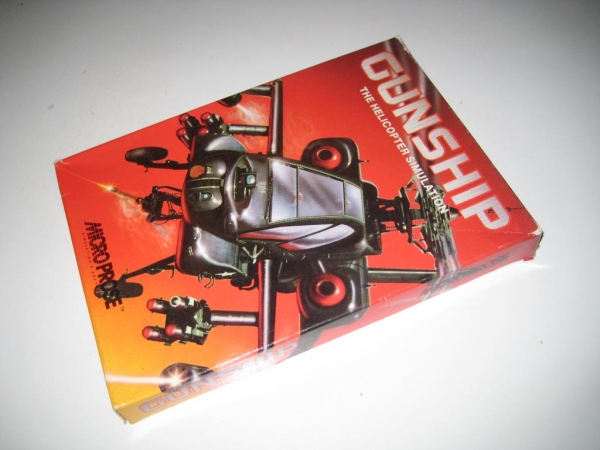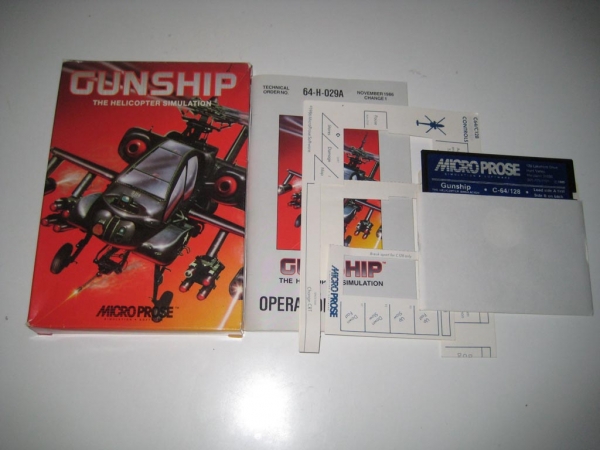Gunship: Classic Helicopter Simulation for the Commodore 64!
Nowadays, everyone has a computer. In fact, you’ve probably got a few just laying around. But just a couple of decades ago, having one was a status symbol, despite the fact that the computers that many of us had weren’t more than glorified gaming consoles. But hey, you put a keyboard on it, and it becomes educational, so it’s much more likely that Mom and Dad are going to go get you an Atari XE than a Sega Master System, right?
Of course, the most ubiquitous of these fancified game systems was the Commodore 64, which was released in 1982 and holds the Guinness World Record for the best-selling computer model of all time. Everyone I knew had a Commodore 64, which meant that acquiring games was no longer a matter of saving up 50 bucks for a new cartridge, but rather spending a few bucks on a pack of blank floppy disks and making copies of all your friends’ games. My two best friend had scads of disks in their disk boxes, which meant I wound up with dozens of games that I might never have discovered on my own. Spy Hunter, Paperboy, Raid on Bungeling Bay, Boulder Dash, Spy vs. Spy, F-15 Strike Eagle, and Ghostbusters were all games that were pirated from my friends before pirating was really even a thing.

Occasionally, though, you really felt the need to acquire a game through traditional, legal means. One such game was MicroProse’s Gunship, a helicopter combat flight simulator released in 1986. The reason you had to actually own this game is because it wasn’t enough just to have the ones and zeroes that made up its code – you needed the manual and the keyboard overlay to really get the full experience.
Gunship was one of the most complex games you could play on a system as limited as the C64, although it looks primitive and archaic in today’s world of PS4s and X-Box Ones. The graphics were as basic as you could get, but they served their purpose. Simple polygons made up enemy craft, buildings, and terrain, much the way that other flight simulators pulled off their landscapes. But the game itself had many layers of complexity, which made it about as realistic as it got for a kid like me who loved stuff like G.I. Joe and Red Dawn.
Once you booted up the game from your disk, you were immediately greeted by the image of an AH-64 Apache Helicopter, rendered beautifully in 8-bit graphics. It rose up from the bottom of the frame, and then the mini-gun mounted under its nose began shooting at the camera, which resulted in the name of the game being spelled out in bold capital letters: GUNSHIP. If that wasn’t enough of an intro, a bleepy synth version of Wagner’s “Ride of the Valkyries” played for about 30 seconds before you were brought to the “password” page, which was a vehicle identification check. This is the first reason why having the manual was important: you might not otherwise know if that tank was an M1A1 Abrams, an M2A1 Bradley, or some Soviet vehicle of death. If you couldn’t identify the vehicle, you couldn’t get to the meat of the game.

Next, you picked your game options. You could pick from several saved game slots, then select your mission. There were easy missions, like flight training or picking off fifth-rate guerrillas in Central America, to more difficult missions, like fighting off Commies in Western Europe or The Middle East. There were also additional levels of difficulty within each individual location, not to mention choosing whether or not to play with realistic physics of flying and landing, or taking the easy way out and going for a simplified control scheme. All of this was done with a graphical user interface you could control with a serial joystick.
After being briefed on your mission and choosing your aircraft’s weaponry (while managing to stay under the maximum weight), it’s time to play the game. You’re off and running on your primary mission, setting your destination on the map and taking out any targets that might come along the way. Sometimes, especially on easier mission, there’s a lot of flying and not much else, so don’t expect nonstop action all along the way. But when you do get in a scuffle with a formidable enemy, like the dreaded Mi-24 Hind Helicopter, your instrument panel shows where you’ve taken on damage and how much of whatever weapon’s ammunition you’ve still got. The guns, missiles, and chaff all come in handy for taking out enemies. Once your primary mission is complete, you can move on to a secondary mission, or take your bird home if you think it’s not going to make it much further. Again, you’ll need the manual for landing clearance, unless you’ve already memorized the countersigns that correspond with each password.


If your mission is successful, you may receive a promotion upon landing. You can get promoted all the way up to Colonel on your missions, with your character’s status being saved on the floppy disk after each mission. You can also accumulate medals such the Purple Heart, Silver Star, and even the Medal of Honor, at which point your character retires as a Brigadier General. Of course, all of that goes away if you’re captured or killed in action (unless you’re quick enough to yank the disk from the drive before that data is saved.)
The keyboard overlay can be a life-saver as well. Knowing which keyboard shortcut fires which weapon, or turns on and off your engines, or takes you to the map or an alternate view in a combat situation makes the game much more enjoyable. The manual itself was so detailed that you almost felt like you could fly the real thing after reading through it. This made it a must-buy game if there ever were one for the Commodore 64. The game was so well-researched and expertly designed that it consumed hundreds of hours of my young life. Every mission was different, and every one had a real payoff.
<

Gunship also has quite an impressive pedigree: one of its primary programmers was Sid Meier, one of the most prolific game designers in history. Meier designed legendary games such as F-15 Strike Eagle, Solo Flight, Silent Service, Railroad Tycoon, and probably his most famous project, Civilization. Aircraft simulators were is forte, especially early in his career, and this one was one of his best in that genre.
There were other versions of the game for the Commodore Amiga, Atari ST, PC Platform, and others as well, and a couple of updated sequels like Gunship 2000 and Gunship! released in later years, but for my money, nothing beats the classic Commodore 64 version. If you’ve got a C64 (or 128) or even have the ability to emulate C64 games, then I can’t recommend this game enough. Just make sure you shell out for the manual and overlay on eBay or wherever else you might get your retro game accessories.

 subscribe to rss
subscribe to rss 

























Leave your response!